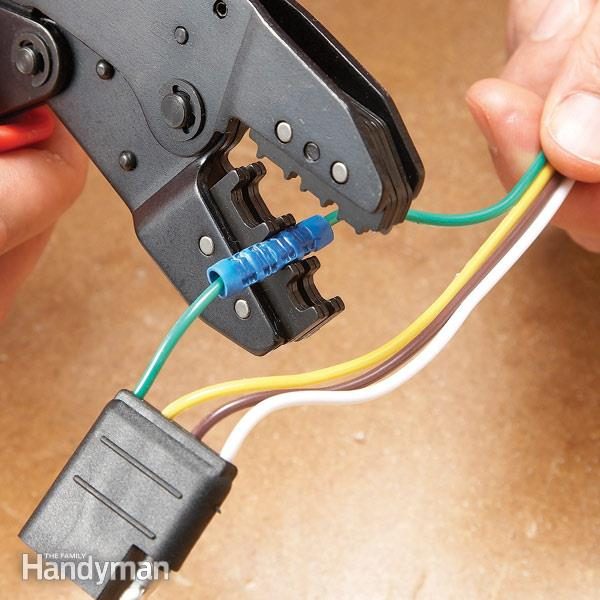Use a professional tool and moisture sealant for first-class results.
Our editors and experts handpick every product we feature. We may earn a commission from your purchases.Learn more.


Use a professional tool and moisture sealant for first-class results.
Our editors and experts handpick every product we feature. We may earn a commission from your purchases.Learn more.
Use a professional crimper and electrical moisture sealant to make quick, solid connections in auto wiring.
Wires can wear out or get damaged from rodents or corrosion, so it’s common to need to splice them from time to time. You might also need to splice wires if you’re rewiring a trailer lamp or installing aftermarket components like a security system.
“Wire splicing represents an essential automotive skill that DIY enthusiasts can easily master,” says Alan Gelfand, owner of German Car Depot. “Practice with non-essential accessory wiring, before moving on to critical systems, like engine management and safety components.”
There are several ways to splice automotive wires. Gelfand’s preferred method is to both crimp them and soldier them together, before adding heat-shrink tubing with built-in adhesive for protection.
“Crimping enables a connection that withstands vibration better than soldering on its own, and the triple protection approach has demonstrated outstanding reliability in tough applications,” he says.
But, if you don’t have access to soldering tools, in many instances you can just use a professional crimper and electrical moisture sealant to make quick, solid connections in auto wiring. Here’s how.
If you decide to splice wires, it’s important to securely splice them because bare wiring can create a short.
“The primary mistake I observe stems from people not giving enough consideration to environmental factors,” says Gelfand. Whether from vibration or corrosion, a compromised splice can cause resistance in the wires, leading to system malfunctions and electrical fires.
Other keys to safely splicing automotive wires include:
Also, always discharge electrical systems before working on them. Depending on your vehicle, that could include more than simply unhooking your battery.
“When it comes to repairing such sensitive things like wiring, pins or connectors, it is extremely important to keep in mind that the quickest repair with minimal effort will always be the inferior repair and will typically lead to failures that will make you end up regretting not spending a few more bucks or hours on doing it the right way,” says Gelfand. “Always prioritize long-term reliability in your repairs rather than quick and easy fixes promised by five-minute YouTube DIY videos.”
Crimp-on wire connectors work well if they’re crimped properly (a 5/16-in.-wide crimp) and sealed (usually with heat-shrinkable tubing). But most cheap crimping tools only make a 1/8-in. crimp, so you’d have to make four of them for a simple butt connection. Buy a professional crimping tool and a roll of electrical moisture sealant.
To start, strip the insulation so only the bare wire is inside the connector. Be careful not to remove excessive insulation, as that creates a short-circuit risks especially if you’re using hardware-store connectors vs. automotive-grade components, says Gelfand.
Then make a single 5/16-in. crimp on each side of the butt connector.
“You need to crimp the wires tightly and securely so they cannot be easily pulled out, otherwise they can lose connection or short-out against other wires in the chassis,” says Chris “Moose” Pyle, a master-certified technician with JustAnswer.

Cut a section of moisture sealant to cover the entire connector and a 1/2-in. overlap on each end.

Double it over and squeeze it together with your fingertips.

You might need to splice car wires to:
“Some European vehicles also require wiring splices to fix common door harness and trunk wiring failure points, which develop from continuous flexing,” says Gelfand.
Yes, but it’s extremely dangerous since vibrations can cause twisted connections to deteriorate. That deterioration leads to increased electrical resistance, which generates heat. That heat prematurely degrades wires and can cause fires. Also, electrical tape can quickly become brittle and break down when exposed to the elements.
“Twisting wires together can result in extensive future repairs, including melted wiring harnesses, damaged control modules and vehicle fires,” says Gelfand. “The additional time required for proper crimped connections and heat-shrink tubing splicing results in years of reliability rather than the short days or weeks of twisted-and-taped repairs.”
Alan Gelfand has been the owner of German Car Depot for more than 30 years. His business is an independent automotive service center in Hollywood, Florida, specializing in the service and repair of German vehicles.
Chris “Moose” Pyle is a master-certified technician with 20-plus years of automotive experience. He has also worked as an expert for JustAnswer since 2006.